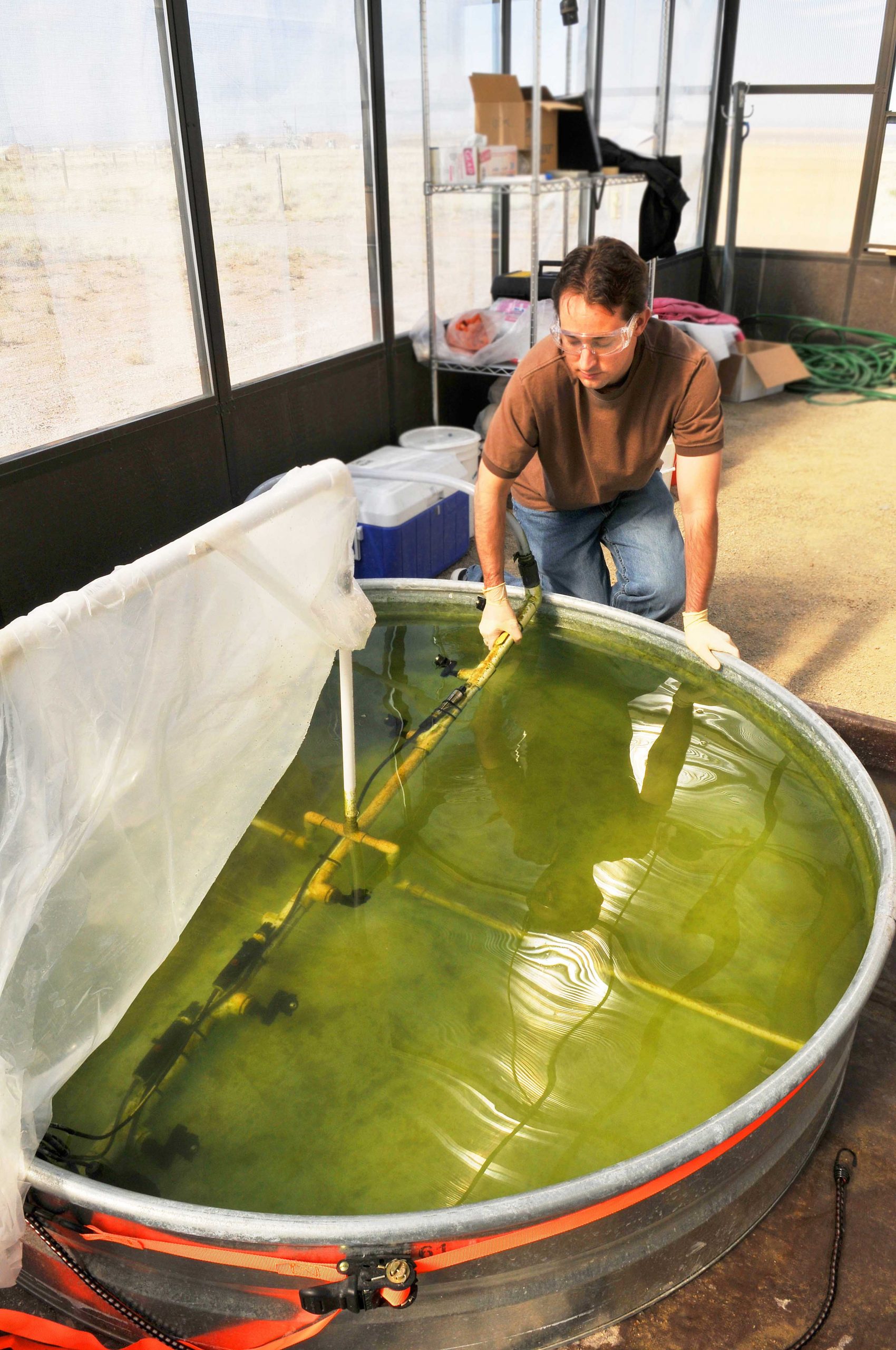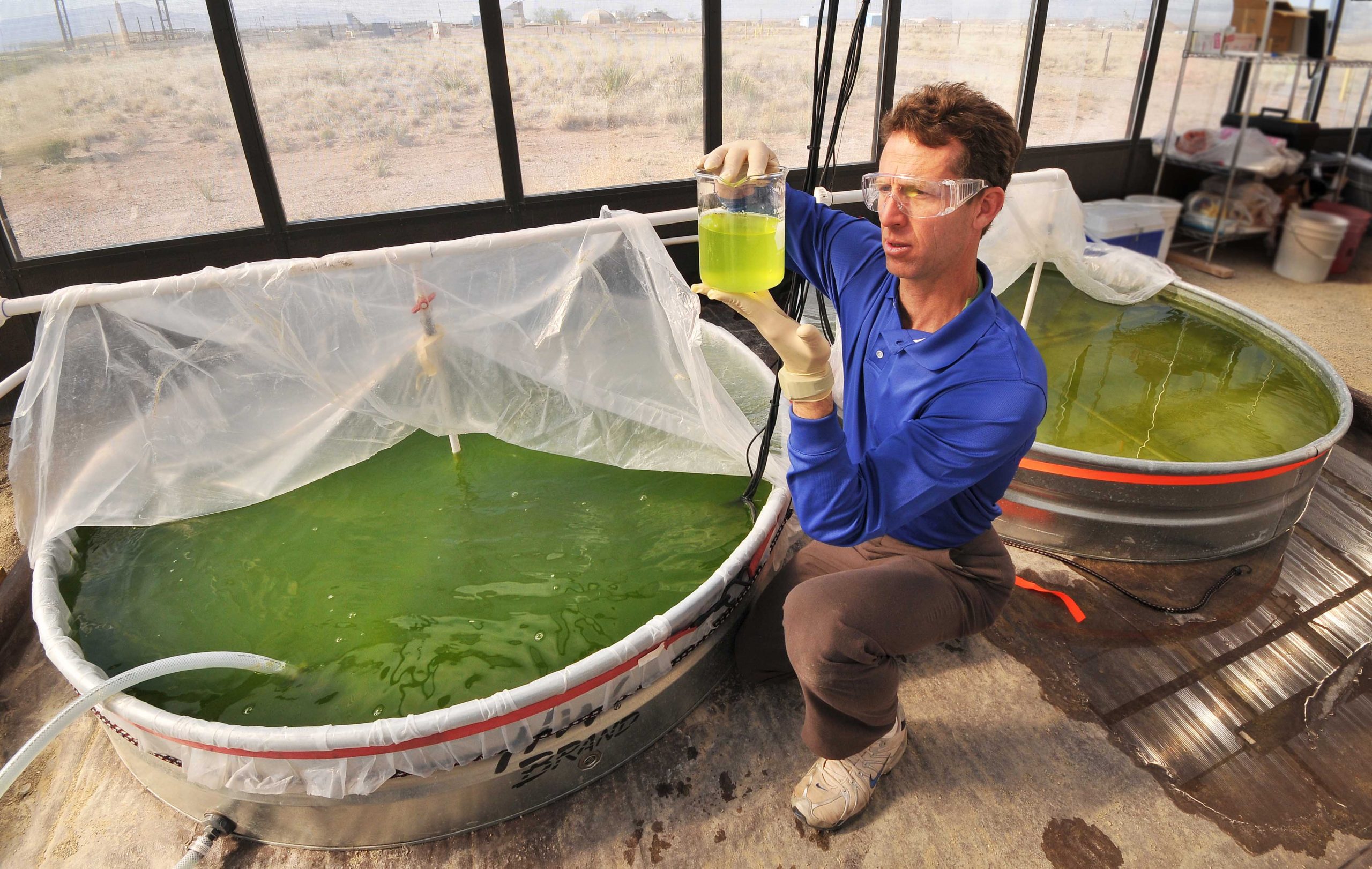Project converts dairy wastes to energy, other products
ALBUQUERQUE, N.M. — As part of a project to create alternative sources of energy, researchers at Sandia National Laboratories are cultivating green algae that holds promise as a new supply of biofuel.
“People have been growing algae for centuries for food supplements for use by man and animals,” said Cecelia Williams, project lead. “It now has the potential to supply our energy needs too.”
Beginning in the 1950s, the Department of Energy recognized algae as a potential feedstock for energy and biofuels and funded the Aquatic Species Program between 1978 and 1996 with $25 million to investigate the production of biofuel from microalgae. DOE terminated the program in the mid-1990s due to low petroleum prices and other priorities. It has only been in the last few years that DOE has once again become interested in algae as a potential source of fuel.
Recently Williams and other Sandia researchers have grown green algae in a 12-by-30-foot greenhouse using a simulated dairy effluent, the nutrient-rich liquid remaining after bacterial digestion of dairy manure. The solids from the digestion of dairy manure can potentially be used to develop fertilizer and feed and the liquid serves as a nutrient source for algae. The algae are typically cultured for several days, followed by harvesting and dewatering, after which the algal oil is extracted. The algae produce lipids, the most useful being neutral oil made up largely of triacyglycerides (TAG) that can be converted to biofuels.
Williams said that growing algae for biofuels eliminates many problems associated with traditional biofuels.
“The current generation of biofuels [starch- and sugar-based ethanol and oil crop-based biodiesel] rely on the use of commodity crops and therefore compete for use of food crops, primarily corn,” she said. “Also, they are very farm-intensive and use a lot of good farming land, fuel and fertilizer inputs and fresh water.”
Algae ponds, on the other hand, can be put on marginal land and grown with non-fresh brackish water produced from energy mineral extraction (petroleum, natural gas, coal-bed methane), or nutrient-loaded wastewater from municipal and agricultural sources. The Southwest has the potential for being a leader in manufacturing this new type of biofuel because “it has lots of barren land that can’t be used for anything else, lots of sunlight and a lot of marginal water,” Sandia researcher Brian Dwyer said.
Sandia scientist Ron Pate noted that Sandia is bringing into play its scientific and engineering expertise to grow and process specific types of algae for biofuels and other useful coproducts. Sandia’s work in this area ties into broader biofuels efforts supported by DOE’s Office of Biomass Program (OBP) that focus on addressing challenges to commercially viable algal biofuels production. This includes participation in the development of the National Algal Biofuels Technology Roadmap Report, which is still in preparation and partnering with others on proposals to establish consortia for algal biofuels and for advanced fungible biofuels with potential funding from OBP. The Algal Biofuels Consortium specifically proposes a broad-based collaboration with Sandia and other national labs, industry and university partners that would pursue research and development of algal biofuels as an affordable, scaleable and sustainable solution that can contribute significantly to meeting the nation’s transportation fuel needs.
Williams anticipates that the Sandia research will have the potential to provide new jobs and economic development to New Mexico, the seventh largest dairy-producing state in the nation. The state’s dairy industry employs more than 5,000 people and has an annual impact of nearly $2.7 billion.
The 340,000 dairy cows in New Mexico produce large quantities of manure and nutrient-rich effluent water that represent a significant waste management problem and regulatory expense to the state’s dairy industry. These and other agri-industrial waste streams represent a valuable and underused feedstock for recycling of energy, biofuels, reusable water and other coproducts. The DOE Algal Biofuels Technology Roadmap currently in draft suggests the use of non-fresh water sources, including agricultural effluent, for algal biomass production. Besides providing a source of non-fresh water and the recycling of needed nutrients, the use of these waste streams in an integrated biorefinery will help to alleviate disposal regulatory requirements on dairies and other confined animal feeding operations in New Mexico and the broader United States.
Sandia’s greenhouse algae project was conceived by Pate and Kyle Hoodenpyle (Ag2Energy) and has been funded by the New Mexico Small Business Association (SBA) and the New Mexico Technology Research Collaborative. The SBA funds Sandia to work with the private-sector partners Ag2Energy and the Pecos Valley Dairy Producers, one of the largest collections of dairy producers in New Mexico. TRC funding lasted one year and the SBA funding is in its final year of a three-year funding cycle.
Future money to research dewatering algae and monitoring the health of algae ponds will come from Sandia’s internal Laboratory Directed Research and Development (LDRD) program and possibly new direct-funded projects from DOE. This research will also allow the greenhouse algae ponds to support other aspects of Sandia’s algae biofuel research portfolio by using the data and information generated from these experiments to evaluate or verify both systems and process models. These models are essential for understanding the economics and risk associated with both the R&D and the scale-up that will be required to make algae an economically viable fuel source for the nation. The ultimate goal is to make algae-derived biofuels competitive with petroleum-based fuels.

